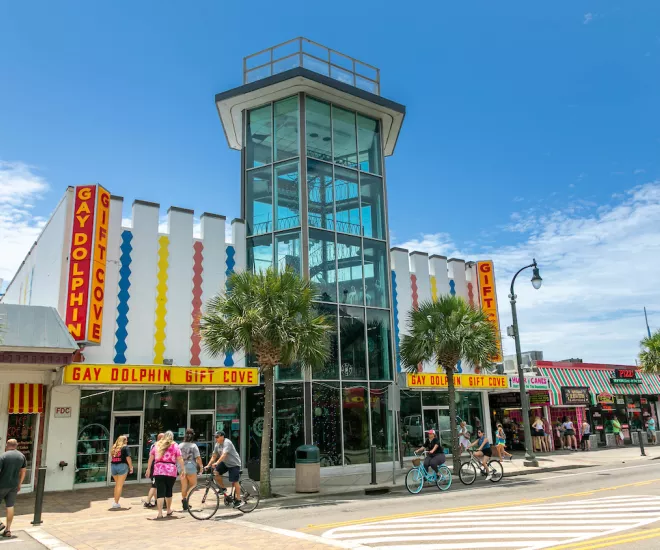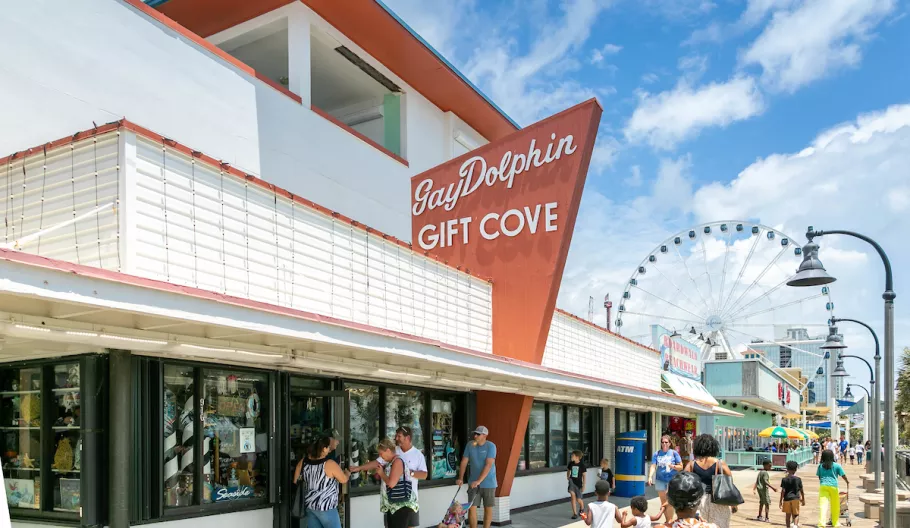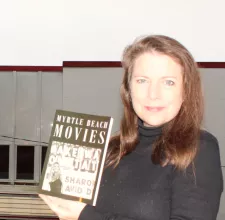The Story Behind Myrtle Beach’s Most Iconic Gift Shop

Since 1946, the Gay Dolphin Gift Cove has been a fixture on North Ocean Boulevard before most every other major tourist attraction in Myrtle Beach came into existence. That includes the former Pavilion that was constructed of fireproof material in 1948 after its predecessor on the same lot between 8th and 9th Avenues North burned down just after Christmas in 1944. Now The Gay Dolphin shares the skyline with other popular entertainment venues including The SkyWheel located adjacent to Plyler Park, named for the gift shop’s founder, Justin Plyler.

His father had run a successful store in Salisbury, North Carolina, until The Depression when his clientele became impoverished and just didn’t have the money to shop anymore. Local millworkers would pay him in bedsheets and towels. As that did not support a sustainable business model, the Plylers packed up and moved to Myrtle Beach. With their wealth of linens, they opened a guesthouse with rooms and apartments named after their son, The JUST-INN.
The Depression was tough on everyone including the citizens of Myrtle Beach, but it was also a time of growth. When the City of Myrtle Beach was granted its Historic District status for the original business district downtown, the professionals whom they had hired to submit their extensive application identified most of the buildings in the district as Depression Era architecture. We have numerous economic indicators still in existence that show how our city’s development continued to flourish, or at least continue to grow, during our nation’s toughest years.
It took some creative financing to make that happen. Chapin Company, which was the department store that anchored the retail sector of Myrtle Beach from the 1920s into the 1970s, for example, would allow their customers to buy what they needed on credit and then pay their tab when the summer tourist dollars began rolling in. Actually, most businesses set up their credit plans that way. Even these days, local banks providing a loan many times don’t set up annual payments in twelve monthly installments. They allocate only three payments at the end of June, July, and August.
Myrtle Beach locals have always had to learn to adapt to conditions in order to make a living. Justin was taught by his parents how to succeed here and inherited their tenacity to do so. His most memorable legacy is the Gay Dolphin. He then passed his attributes and the store to his son, Buz.
When Buz was five, it didn’t look like that legacy would be his one day. On October 15th, 1954, Hurricane Hazel hit Myrtle Beach on a high tide under a full moon. It was a Category 4 storm that, to this day, was the worst natural disaster the Grand Strand has had to endure. In preparation, the Plyler Family pulled a flatbed truck beside the store and loaded up the most valuable merchandise and then evacuated to the then elementary school, where the post office is now between 5th and 6th Avenues North. Everything left behind was lost. That was true for most homes and businesses along the oceanfront. The silver lining was that the property owners were then eligible for small business loans and a renaissance took place. 1954 is considered by some as the turning point in Myrtle Beach’s history and denotes its coming of age.
Depression Era architecture began to be replaced by mid-century modern design. The most distinctive example is the Gay Dolphin itself and the Plylers have faithfully maintained its now-retro appearance. The glass tower that encases a circular staircase that wraps around a waterfall of oil beads is the most prominent feature.
When I was a child, the staircase windows were filled with oversized stuffed animals of every color and species. About halfway up there was a turnstile. For twenty-five cents, you could gain access to the upper stairs. However, a few lucky visitors could go up for free. All you had to do was go to the main level of the store near the Boulevard entrance where thousands of mini license plates are still on display. Each has a name with multiple spellings to choose from. If they didn’t have your name spelled correctly, you got a free pass at that turnstile. They even had my often-misspelled moniker, so I always had to come up with a quarter.
When you reached the top, you would find a door to the building’s roof. The Plylers kept an oceanfront home on that level. Once up there, you would immediately see an even smaller circular staircase that took you to the rooftop of the tower. The open-air deck with large glass windows for your safety gave you the best view of the Boulevard. Even when I grew up and moved away, I would make a point to go up there on each visit home. What I presume are even more safety-conscious times today, customers can no longer leave the tower’s interior.
Before my time, there were significant tourist attractions that the Plylers were behind in addition to the store. At the very beginning, they had the Gay Dolphin Park that was an amusement park for children and the store was its namesake. Justin wanted a name that was “happy” and “nautical.” In 1946, a viable option was “Gay Dolphin”, and the name has stuck despite changes in word meanings.
Over the years the Plylers had anything from a bingo hall to a putt-putt golf course to something akin to a dunk tank in the post-WWII years where former GIs could throw balls at “their drill sergeant.” To host these attractions, Justin would go to state fairs and the like to hire carnival workers, also known as carnies, to lure customers in to enjoy whatever spectacle they were featuring that season.
Marine life and wildlife shows were also popular. At one point, they had upwards of two dozen monkeys of various types on display.
My favorite story from Buz’s childhood involved an even larger primate. That summer’s big draw was what they called a Gorillaland Show. I don’t know how he managed to do it, but Buz either entered the female gorilla cage or stood too close and got pulled in. She, the gorilla, was apparently feeling very motherly and began to cradle the young Buz and was not inclined to let him go.
Meanwhile, the carnies in charge of the exhibition discovered what had happened and they were scared. They weren’t so concerned with Buz’s fate, but were very fearful of what his dad, their boss, would do when he found out. So they didn’t tell him!
Well, eventually, Justin began to realize that his son was missing and found out what was going on. I can’t imagine what he thought, but he kept a cool head. Justin was a smart man. According to Buz, he had an IQ of 160.
He knew that the gorilla didn’t like the carnies, but there was one person (other than Buz) with whom she had formed an attachment. Her name was Myrtle Sloan, and her husband was the pony ride handler. Justin knew that she would be the only one to negotiate his son’s release. Her gentle approach, and perhaps because the gorilla had grown tired of holding the boy led to a happy ending to Buz’s EIGHT-HOUR ordeal.
